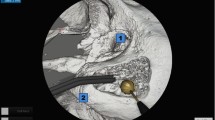Abstract
Purpose
Bone drilling simulators with virtual and haptic feedback provide a safe, cost-effective and repeatable alternative to traditional surgical training methods. To develop such a simulator, accurate haptic rendering based on a force model is required to feedback bone drilling forces based on user input. Current predictive bone drilling force models based on bovine bones with various drilling conditions and parameters are not representative of the bone drilling process in bone surgery. The objective of this study was to provide a bone drilling force model for haptic rendering based on calibration and validation experiments in fresh cadaveric bones with different bone densities.
Methods
Using a commonly used drill bit geometry (2 mm diameter), feed rates (20–60 mm/min) and spindle speeds (4000–6000 rpm) in orthognathic surgeries, the bone drilling forces of specimens from two groups were measured and the calibration coefficients of the specific normal and frictional pressures were determined.
Results
The comparison of the predicted forces and the measured forces from validation experiments with a large range of feed rates and spindle speeds demonstrates that the proposed bone drilling forces can predict the trends and average forces well.
Conclusion
The presented bone drilling force model can be used for haptic rendering in surgical simulators.






Similar content being viewed by others
References
Coles TR, Meglan D, John NW (2011) The role of haptics in medical training simulators: a survey of the state of the art. IEEE Trans Haptics 4(1):51–66
Hamza-Lup FG, Bogdan CM, Popovici DM, Costea OD (2011) A survey of visuo-haptic simulation in surgical training. In: eLmL 2011, The Third International Conference on Mobile, Hybrid, and On-line Learning
Tsai MD, Hsieh MS, Tsai CH (2007) Bone drilling haptic interaction for orthopedic surgical simulator. Comput Biol Med 37(12):1709–1718
Konukseven EI, Önder ME, Mumcuoglu E, Kisnisci RS (2010) Development of a visio-haptic integrated dental training simulation system. J Dent Educ 74(8):880–891
Wang DX, Zhang YR, Wang Y, Lü PJ, Zhou RG, Zhou WL (2009) Haptic rendering for dental training system. Sci China Ser F Inf Sci 52(3):529–546
Arbabtafti M, Moghaddam M, Nahvi A, Mahvash M, Richardson B, Shirinzadeh B (2011) Physics-based haptic simulation of bone machining. IEEE Trans Haptics 4(1):39–50
Fei Zheng, Feng Lu Wen, San Wong Yoke, Weng Chiong Foong Kelvin (2012) An analytical drilling force model and GPU-accelerated haptics-based simulation framework of the pilot drilling procedure for micro-implants surgery training. Comput Methods Programs Biomed 108(3):1170–1184
James TP, Pearlman JJ, Saigal A (2013) Predictive force model for haptic feedback in bone sawing. Med Eng Phys 35(11):1638–1644
Wang W, Wang Wendong, Shi Yikai, Yang Ning, Yuan Xiaoqing (2014) Experimental analysis of drilling process in cortical bone. Med Eng Phys 36(2):261–266
Lin Yanping, Xudong Wang, Fule Wu, Chen Xiaojun, Wang Chengtao, Shen Guofang (2014) Development and validation of a surgical training simulator with haptic feedback for learning bone-sawing skill. J Biomed Inf 48:122–129
Lee JE, Gozen BA, Ozdoganlar OB (2012) Modeling and experimentation of bone drilling forces. J Biomech 45(6):1076–1083
Tuijthof GJM, Frühwirt C, Kment C (2013) Influence of tool geometry on drilling performance of cortical and trabecular bone. Med Eng Phys 35(8):1165–1172
Alam K, Mitrofanov AV, Silberschmidt VV (2011) Experimental investigations of forces and torque in conventional and ultrasonically-assisted drilling of cortical bone. Med Eng Phys 33(2):234–239
Jacob CH, Berry JT, Pope MH, Hoaglund FT (1976) A study of the bone machining process—drilling. J Biomech 9(5):343–349
MacAvelia T, Salahi M, Olsen M, Crookshank M, Schemitsch EH, Ghasempoor A, Janabi-Sharifi F, Zdero R (2012) Biomechanical measurements of surgical drilling force and torque in human versus artificial femurs. J Biomech Eng 134:124503-1–9
Langella A, Nele L, Maio A (2005) A torque and thrust prediction model for drilling of composite materials. Compos Part A Appl Sci Manuf 36(1):83–93
Xu D, Shen XK, Mo ZH, Fan Y (2011) Empirical formula and experiment based force modeling for haptic spine surgery simulation. Int J Model Simul Sci Comput 02(01):29–44
Töyräs J, Nieminen MT, Kröger H, Jurvelin JS (2002) Bone mineral density, ultrasound velocity, and broadband attenuation predict mechanical properties of trabecular bone differently. Bone 31(4):503–507
Norton MR, Gamble C (2001) Bone classification: an objective scale of bone density using the computerized tomography scan. Clin Oral Implants Res 12(1):79–84
Acknowledgments
This study was funded by the National Natural Science Foundation of China (Grant Nos. 81372017 and 51575343).
Author information
Authors and Affiliations
Corresponding author
Ethics declarations
Conflict of interest
The authors declare that they have no conflict of interest.
Additional information
Yanping Lin and Huajiang Chen have contributed equally to this work.
Rights and permissions
About this article
Cite this article
Lin, Y., Chen, H., Yu, D. et al. A predictive bone drilling force model for haptic rendering with experimental validation using fresh cadaveric bone. Int J CARS 12, 91–98 (2017). https://doi.org/10.1007/s11548-016-1463-7
Received:
Accepted:
Published:
Issue Date:
DOI: https://doi.org/10.1007/s11548-016-1463-7




